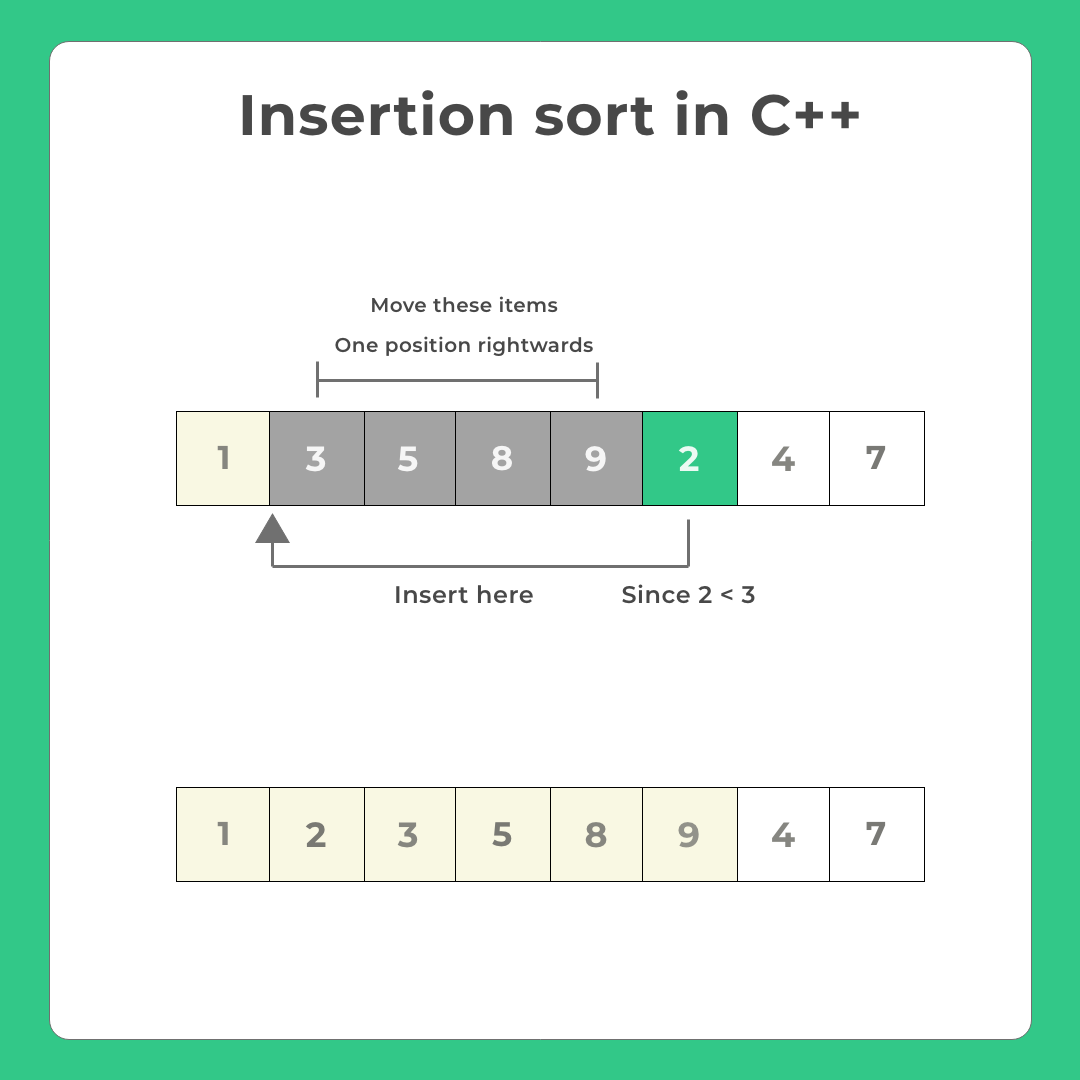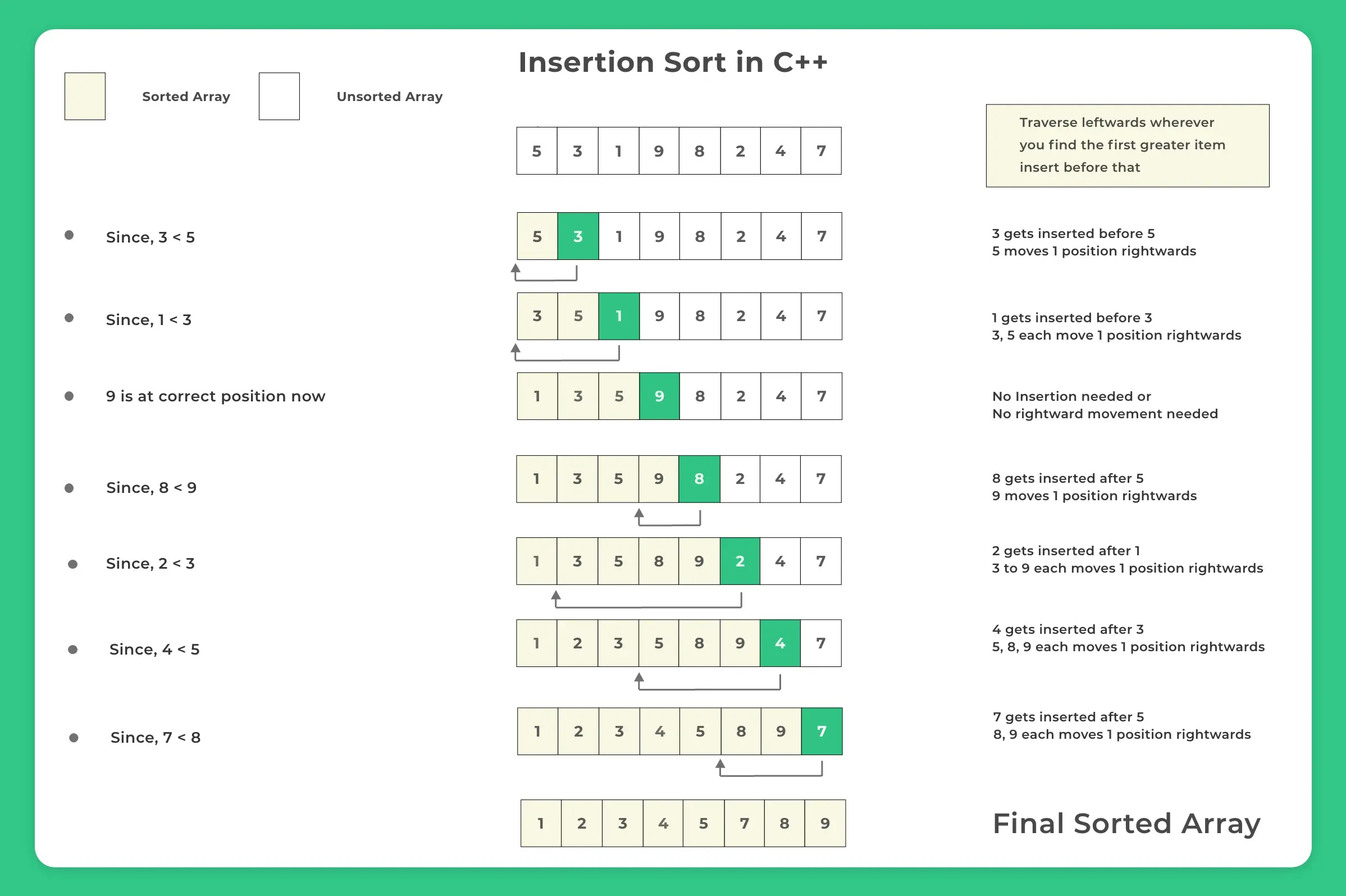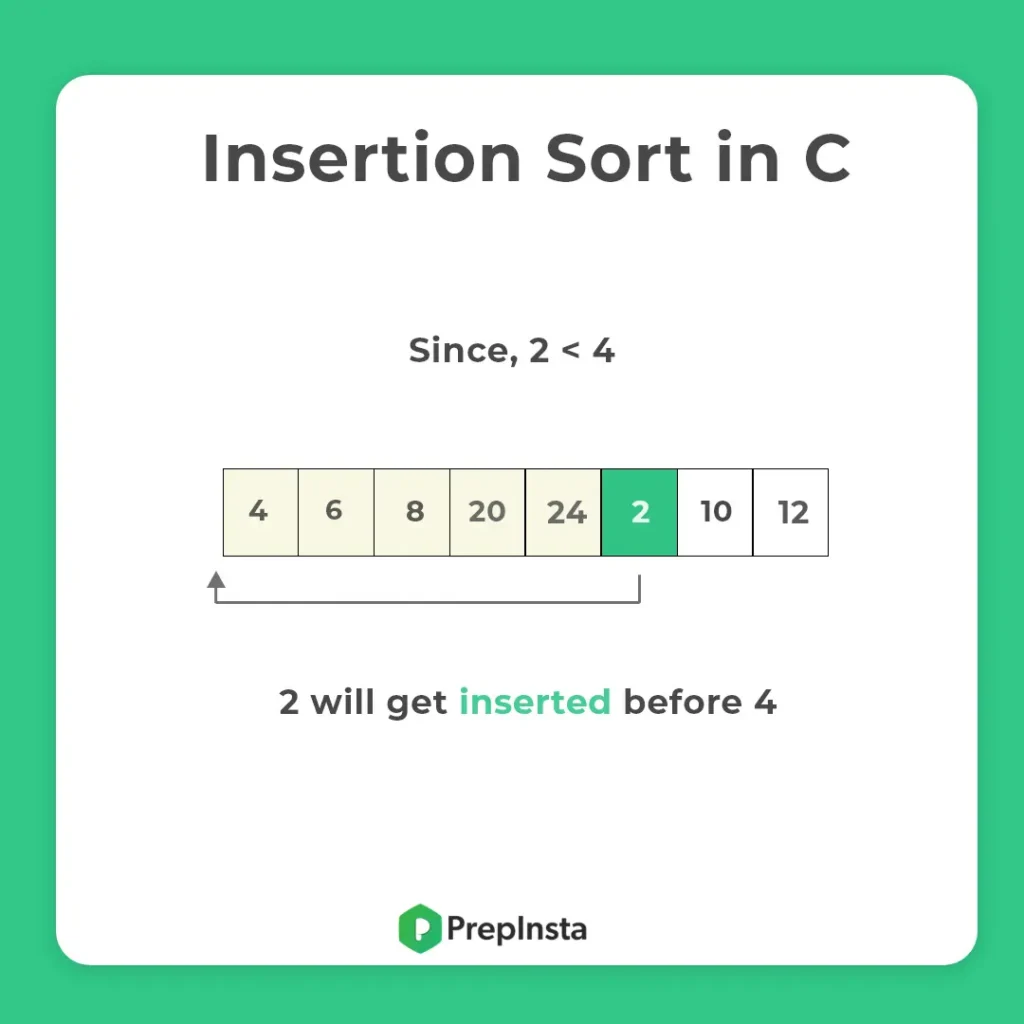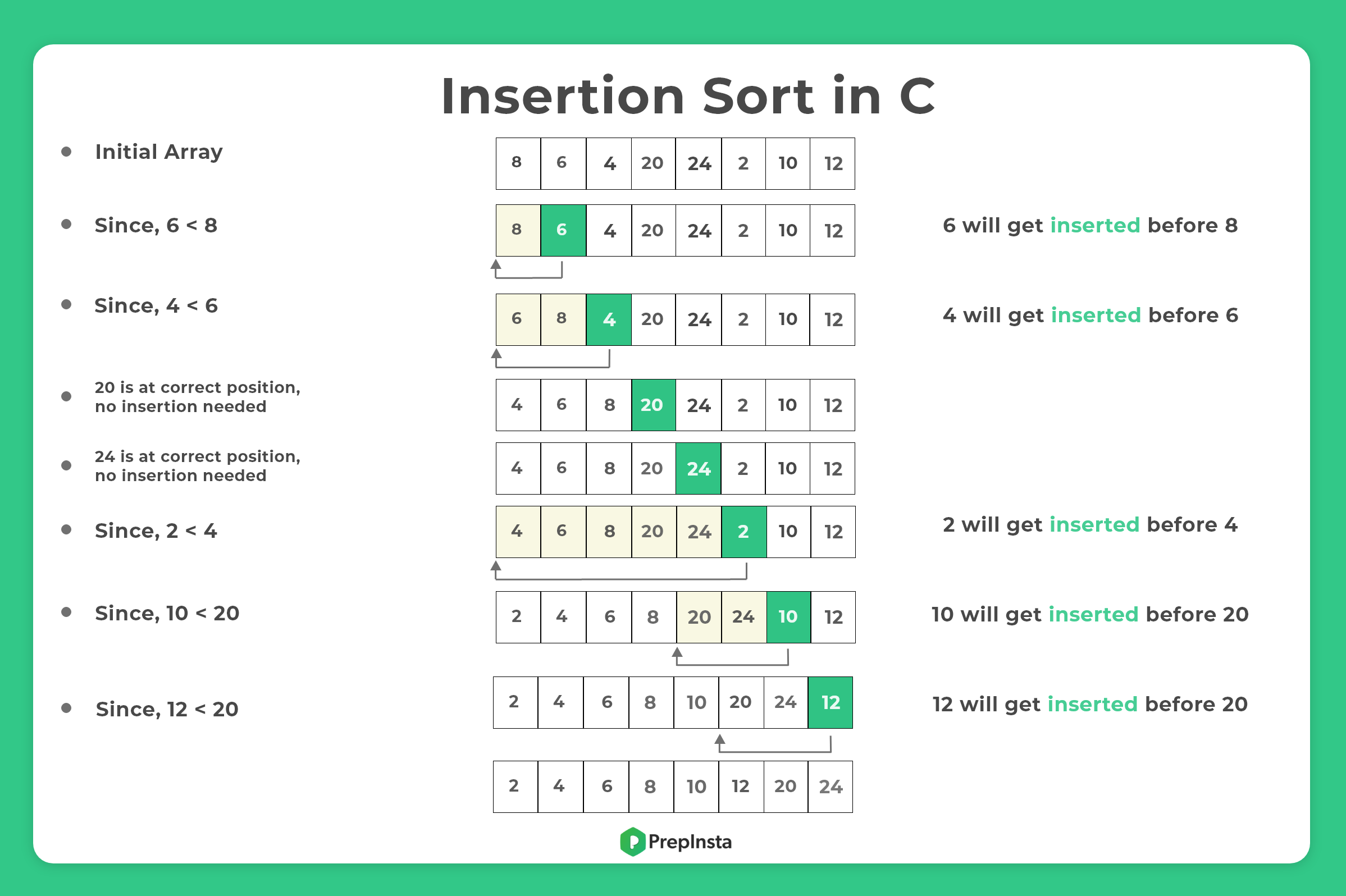Insertion Sort in C++
What is Insertion Sort in C++?
Rearranging data in a logical order is known as sorting i.e. arranging of data in ascending or descending order. In this article, we will learn about insertion sort in C++.
Insertion sorting is done in the same way as we sort our cards in while we play games of cards
| Time Complexity | O(n2) |
| Best Case | Ω(n) |
| Worst Case | O(n2) |
| Aux. Space Complexity | O(1) |
| Best case when | Array is already sorted |
| Worst case when | Array is reverse sorted |

What is Insertion Sort in C++?
Rearranging data in a logical order is known as sorting i.e. arranging of data in ascending or descending order. In this article, we will learn about insertion sort in C++.
Insertion sorting is done in the same way as we sort our cards in while we play games of cards
| Time Complexity | O(n2) |
| Best Case | Ω(n) |
| Worst Case | O(n2) |
| Aux. Space Complexity | O(1) |
| Best case when | Array is already sorted |
| Worst case when | Array is reverse sorted |

Insertion Sort in C++
If there are n element and it requires (n-1) pass to sort them then, at each pass we insert current element in the appropriate position so that the element are in order. Some characteristics of insertion sort in C++.
- A sub-list is maintained which is always in sorted order.
- It is better then Selection Sort and Bubble Sort algorithms.
- It is efficient for smaller data sets but inefficient for larger data sets.
- Its space complexity is less.
- It does not change the relative order of elements which are equal.


Execution of insertion sort in C++
- It’s almost similar to how we play cards.
- At any given time, one part of the array will be sorted and one part will be unsorted.
- We will pick the leftmost item from the unsorted part
- Insert this item at the correct position in the sorted array
You can check the implementation of the same below


Algorithm for insertion sort in C++
- INSERTION-SORT(A)
- for i = 1 to n
- key ← A [i]
- j ← i – 1
- while j > = 0 and A[j] > key
- A[j+1] ← A[j]
- j ← j – 1
- End while
- A[j+1] ← key
- End for
Program for insertion sort in C++
// C++ Program for Insertion Sort
// Time Complexity : O(N^2)
// Space Compelexity : O(1)
// Best Case : When already Sorted, Worst Case : When reverse Sorted
#include<iostream>
using namespace std;
//Function to print array.
void display(int arr[], int size)
{
int i;
for (i = 0; i < size; i++)
cout << arr[i] << "\t";
cout << "\n";
}
//Main function to run the program.
int main()
{
int array[] = {5, 3, 1, 9, 8, 2, 4,7};
int size = sizeof(array)/sizeof(array[0]);
cout << "Before Insertion sort: \n";
display(array, size);
int i, key, j;
for (i = 1; i < size; i++) { key = array[i]; j = i - 1; /* Here the elements in b/w arrary[i-1 & 0] which are greater than key are moved ahead by 1 position each*/ while (j >= 0 && array[j] > key)
{
array[j + 1] = array[j];
j = j - 1; // moving backwards
}
// placing key item now
array[j + 1] = key;
}
cout << "After Insertion sort: \n";
display(array, size);
return 0;
}Output
Before Insertion sort: 5 3 1 9 8 2 4 7 After Insertion sort: 1 2 3 4 5 7 8 9
Pros and Cons of Insertion Sort Algorithm
Pros
- Anyone can write it is moderately easy to understand
- Only O(1) space requirements
- For a smaller number of items in an array it’s quicker than merge sort
Cons
- Not so good average time complexity of O(n2)
- If there are large elements then it gives bad performance because of O(n^2) time complexity
- Shifting items because of insertion can be costly
Other information
- Best Case: If already sorted data set
- Worst Case: Sorted data set but in the opposite order


Get PrepInsta Prime & get Access to all 200+ courses offered by PrepInsta in One Subscription
Sorting
Sorting algorithms are easy to learn but are really important for college semester exams and companies offering package between 3 – 6 LPA would ask direct searching questions in online test/ interviews.

Get over 200+ course One Subscription
Courses like AI/ML, Cloud Computing, Ethical Hacking, C, C++, Java, Python, DSA (All Languages), Competitive Coding (All Languages), TCS, Infosys, Wipro, Amazon, DBMS, SQL and others
Insertion Sort in C
How Insertion Sort works in C
In this technique, we pick an Element and then insert it at the appropriate position in ascending and descending order.
The inspiration has been taken from playing cards
| Time Complexity | O(n2) |
| Best Case | Ω(n) |
| Worst Case | O(n2) |
| Aux. Space Complexity | O(1) |
| Best case when | Array is already sorted |
| Worst case when | Array is reverse sorted |

Insertion Sort in C
Insertion sort is just like how to sort playing cards in your hands. You pick one card and try to place that card in its correct position.
The array is kind of split into a sorted part and an unsorted part. A value from the unsorted part is picked and placed into its correct position in the sorted part.
Below are examples on how you can do the same.

Execution of Insertion Sort in C

Approach of Insertion Sort
- Iterate over the whole array, picking each item in the array once iteratively
- Call this picked item key
- If this key item is smaller than its predecessor, compare it to the item before
- To make space for this swapped item move items greater than key one position right
- Keep doing this until you find a smaller element than key element.
Code of Insertion Sort
#include<stdio.h>
// Function to print array
void display(int arr[], int size)
{
int i;
for (i = 0; i < size; i++)
printf("%d ", arr[i]);
printf("\n");
}
// Main function to run the program
int main()
{
int array[] = {8, 6, 4, 20, 24, 2, 10, 12};
int size = sizeof(array)/sizeof(array[0]);
printf("Before Insertion sort: \n");
display(array, size);
int i, key, j;
for (i = 1; i < size; i++)
{
key = array[i];
j = i - 1;
/* Here the elements in b/w array[0 to i-1]
which are greater than key are moved ahead
by 1 position each*/
while (j >= 0 && array[j] > key)
{
array[j + 1] = array[j];
j = j - 1;
}
// placing element at its correct position
array[j + 1] = key;
}
printf("After Insertion sort: \n");
display(array, size);
return 0;
}
// Time Complexity : O(n^2)
// Auxiliary Space : O(1)
Output:
Before Insertion sort: 8 6 4 20 24 2 10 12 After Insertion sort: 2 4 6 8 10 12 20 24
#include<stdio.h>
// Here we are implementing Insertion sort
void insertionSort(int array[], int size)
{
int i, key, j;
for (i = 1; i < size; i++)
{
key = array[i];
j = i - 1;
/* Here the elements in b/w array[0 to i-1]
which are greater than key are moved ahead
by 1 position each*/
while (j >= 0 && array[j] > key)
{
array[j + 1] = array[j];
j = j - 1;
}
array[j + 1] = key;
}
}
/* Function to print array */
void display(int arr[], int size)
{
int i;
for (i=0; i < size; i++)
printf("%d ", arr[i]);
printf("\n");
}
// Main function to run the program
int main()
{
int array[] = {5, 3, 1, 9, 8, 2, 4, 7};
int size = sizeof(array)/sizeof(array[0]);
printf("Before Insertion sort: \n");
display(array, size);
insertionSort(array, size);
printf("After Insertion sort: \n");
display(array, size);
return 0;
}
// Time Complexity : O(n^2)
// Auxiliary Space : O(1)
Output:
Before Insertion sort: 5 3 1 9 8 2 4 7 After Insertion sort: 1 2 3 4 5 7 8 9
Some facts about Insertion sort
- Time Complexity: O(n2)
- Auxiliary Space: O(1)
- Best Case: Ω(n), when the array is already sorted
- Worst Case: Θ(n^2), when the array is reverse sorted.
- Algorithmic Paradigm: Incremental Approach
- Sorting In Place: Yes
- Stable: Yes
Advantages and Disadvantages of Insertion Sort
Advantages
- It is simple, small and easy to write.
- It doesn’t use a lot of overhead.
- It uses in place sorting, thus O(1) space requirements
- If data is almost sorted, then it can be very fast approaching O(n) and faster than Merge sort(for sorted data, and small N, else merge sort is faster)
- Efficient for (quite) small data sets.
Disadvantages
- Poor average time complexity of O(n2)
- If there are a large number of elements then it is inefficient
- Many items needs to be shifted to one insertion
Properties
- You will encounter the best case if the data is already or nearly sorted
- It will give worst-case results if the array is sorted in the opposite order as required

Time Complexity
For Linear Search
Best
Ω(n)
Average
Worst
Space Complexity
O(1)
Time Complexity
For Linear Search
Best
O(n)
Average
Worst
Space Complexity
O(1)

Quiz Time

Question 1. How many passes does an insertion sort algorithm consist of? –
- N-1
- N-2
- N
- N2
(Flipkart – HackerEarth Test)
Explanation: An insertion algorithm consists of N-1 passes when an array of N elements is given.

Question 2. For the following question, how will the array elements look like after second pass?
35, 7, 64, 57, 28, 14
- 8, 21, 32, 34, 51, 64
- 8, 32, 34, 51, 64, 21
- 8, 34, 51, 64, 32, 21
- 8, 34, 64, 51, 32, 21
(TCS NQT)
Original Array :
35, 7, 64, 57, 28, 14
After Pass 1 : 7, 35, 64, 57, 28, 14
After Pass 2 : 7, 35, 64, 57, 28, 14 (no change)
After Pass 3 : 7, 35, 57, 64, 28, 21 (no swapping)
After Pass 4 : 7, 28, 35, 57, 64, 14 (no swapping)
Sorting
Sorting algorithms are easy to learn but are really important for college semester exams and companies offering package between 3 – 6 LPA would ask direct searching questions in online test/ interviews.



Login/Signup to comment